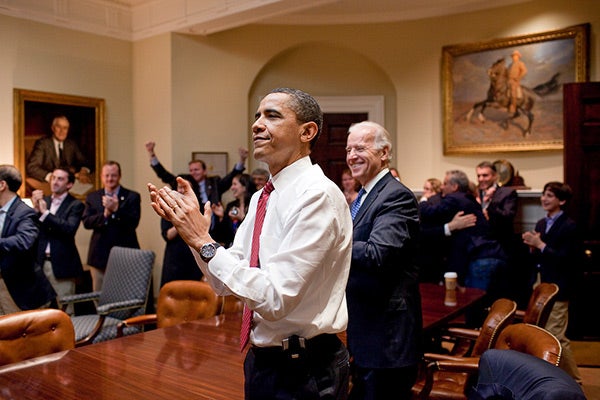|
October 24, 2012
What does Obamacare actually do, you ask? You're not alone, says Stanford pollster
A national survey led by Stanford pollster Jon Krosnick finds that confusion reigns when it comes to the contents of the Affordable Care Act. But the more they know, the more people seem to like it. By Max McClure

President Barack Obama, Vice President Joe Biden and senior staff react in the Roosevelt Room of the White House as the House passes the health care reform bill, March 21, 2010. More than two years later, the majority of Americans still don't understand the details of the law, says Stanford pollster Jon Krosnick. (Photo: Pete Souza / White House)
Even in the hermetic world of American health care, the Patient Protection and Affordable Care Act of 2010 has a reputation for inscrutability. It's 900 pages long, addresses famously arcane aspects of health coverage, and does so in excruciating, if necessary, detail.
It's also proven extraordinarily divisive. The bill passed with a single Republican vote. In the weeks following its signing, supporters and opponents alike held prayer vigils, vandalized offices and issued death threats. Since then, public opinion has remained more or less evenly split, with a number of recent polls suggesting a shift toward unpopularity.
According to a new survey, all this has happened with hardly any Americans understanding what's in the law.
Stanford professor of communication and political science Jon Krosnick recently quizzed thousands of respondents nationwide on the contents of the legislation.
"We found nobody, literally nobody in the country, who answered all the quiz questions correctly," he said.
The number of questions they were able to answer correctly mattered: The more people knew about the law, the more likely they were to support it.
The study – conducted in collaboration with the Associated Press and the survey research firm GfK – predicts that if everyone in the country were able to answer the quiz perfectly, the law's approval ratings would jump from 32 percent to 70 percent.
A paper reporting the team's findings draws on national surveys conducted in 2010 and 2012.
Preexisting conditions and death panels
The survey listed 12 provisions of the bill, including "Insurance companies have to sell insurance to people with preexisting conditions," "Discounts on prescriptions for seniors with high drug costs" and "Federal tax credits for small companies that buy insurance for their employees."
Only one – the provision that allows children under 26 to remain on their parents' health insurance – was correctly identified with high certainty by a majority of respondents.
Similarly, none of the six incorrect statements were confidently identified as such by more than 50 percent of respondents. Only 17 percent of those surveyed stated with certainty that "death panels" – the focus of inaccurate statements leveled by Sarah Palin against the bill in 2009 – were not created by the legislation.
Overall, only 14 percent of respondents answered a majority of questions correctly with a high degree of certainty.
Perfect understanding
The researchers found that the better a person understood the law the more likely he or she was to favor it.
Based on the relationship between understanding and approval rates for the act, an independent with a perfect score, if there were one, would be 15.7 times more likely to favor the bill than one who answered no questions correctly.
Currently, the law is viewed along strict partisan lines – only 8 percent of Republicans are in favor of it. With perfect knowledge, however, the researchers predict that 40 percent of Republicans would favor the legislation.
The study didn't directly test whether being more informed about the law causes people to like it more, or whether the effect is the other way around. But the researchers did find that the bill's component parts weren't nearly as controversial as the bill as a whole.
Majorities of respondents favored nine of the 12 listed provisions of the plan when they weren't explicitly told that they were included in the legislation.
Only three components were not supported by a majority of Americans: "U.S. citizens without health insurance have to pay fines if they don't have specific reasons," "New fees for companies that make drugs" and "New fees for health insurance companies."
The reasons for the persistent shortcoming of public understanding of the bill are unclear.
"It's tempting to blame the public for failing to learn about this law," said Krosnick. "But it is also true that Mr. Obama could have done much more to educate the public about his centerpiece legislation.”
The two polls were conducted between Aug. 31 and Sept. 7, 2010, and between Aug. 3 and 13, 2012, sampling 1,271 and 1,334 adults nationwide, respectively.
-30-
|